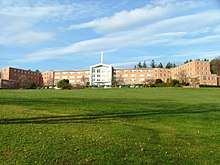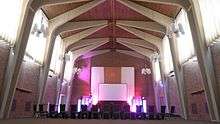Kripalu Center
The Kripalu Center for Yoga & Health is a non-profit organization that operates a health and yoga retreat in Stockbridge, Massachusetts.[1] Its 160,000-square-foot (15,000 m2) facility is a former Jesuit novitiate and juniorate seminary built in 1957.[2] When it was founded by Amrit Desai, it had a traditional guru-disciple structure. Desai left in 1994, and in 1999 Kripalu became secular. The center has described itself as North America's largest residential facility for holistic health and education.[3] With 2013 revenue of $34.7 million, it employed about 626 people as of 2008 and can accommodate more than 650 overnight guests.[4]
 Kripalu Center for Yoga & Health | |
| Former names | Yoga Society of Pennsylvania |
|---|---|
| Location | Stockbridge, Massachusetts |
| Type | Retreat |
| Opened | 1983 |
| Website | |
| www | |
History
Amrit Desai came from India in 1960 as a student at the Philadelphia College of Art. As instructed by his guru, Swami Kripalu, Desai taught yoga in Philadelphia. In 1966, he co-founded the Yoga Society of Pennsylvania.[5] In 1972, Desai set up a residential yoga center in Sumneytown, Pennsylvania.[5] In 1974, the organization's name was changed to "Kripalu Yoga Fellowship"; it taught Swami Kripalu's teachings, held retreats and other programs, and trained yoga teachers.[5] In 1975, Kripalu bought Summit Station, Pennsylvania, including a health center that became a key element of its mission.[5] In 1977, Swami Kripalu moved to the United States, inspiring many people to take up yoga. He returned to India in 1981.[5] The current Stockbridge, Massachusetts location, a former Jesuit seminary on a property called Shadowbrook, opened in December 1983.[5] During the 1980s, Kripalu grew to have over 350 residents. In 1994, it was discovered that Desai had had sexual relationships with female residents, and he was forced to resign.[5] In 1999, Kripalu changed from a religious order to a standard non-profit organisation; it notes on its website that it "has the distinction of being the first, and possibly the only, yoga center in North America to survive the transition from a traditional guru-disciple structure to a secular, all-inclusive center".[5][6]
Kripalu hosts over 700 programs a year in its Schools of Yoga, Ayurveda, and Integrative Yoga Therapy;[5] its Institute of Extraordinary Living, founded by Kripalu's scholar-in-residence Stephen Cope;[7] and its conscious leadership program.[5]
Kripalu Yoga
Kripalu Yoga is a form of Hatha Yoga that combines asanas, pranayama, and meditation.[8] The organization claims that its teaching is "following the flow" of prana, or "life-force energy, compassionate self-acceptance, observing the activity of the mind without judgment, and taking what is learned into daily life."[9]
Facility
Kripalu's 100 acres (40 ha), include forests, lawns, gardens, and access to Lake Mahkeenac.[10][11] Conservation easements on 225 of the acres were granted in 1997 using a framework of the U.S. Forest Legacy Program.[12][13]

Kripalu's principal 160,000-square-foot (15,000 m2) building was constructed by the Jesuits in 1957 to replace the Gilded Age mansion "Shadowbrook Cottage." The Jesuits had planned to demolish the mansion due to high maintenance costs, but prior to demolition, the mansion was destroyed by a fire in 1956 which resulted in several fatalities. Jesuits had acquired the former estate in 1922 as a novitiate, but moved away in 1970.[14][15]
A $15 million, six-story housing annex with 80 guest rooms, was completed in 2010. Designed by architect Peter Rose, the annex incorporates sustainable design elements[16] and won a 2010 award for specialized housing from the American Institute of Architects. The institute commented on the building's interior natural lighting, and noted that the architectural design and climate control systems are integrated and consume 40 percent less energy than a conventional building.[17] Rose also developed a master plan for increasing the center's capacity and developing it into "a model of environmental responsibility" through improvements to existing buildings, landscaping, and new construction.[18]
Kripalu Center for Yoga & Health formerly operated its own water supply. Groundwater from onsite wells was used for its water supply source, supplemented by water purchased from the Lenox water department.[19] There were regulatory agency "concerns" resulting in at least two enforcement actions about the water supply's potential vulnerability to contamination,[19][20][21] and as of 2009 the center's water supply had been converted to rely solely on purchased water obtained from surface water sources.[22]
Programs
As of 2008, Kripalu Center in Stockbridge said it offered more than 750 programs and spiritual retreats attended by about 25,000 people annually.[23] Total annual visitation is reported to be about 30,000 people. Many workshops are conducted by outside presenters.[24] Kripalu Center also offers a semester-long program for young adults; projects in music, weight loss and post-traumatic stress disorder.
About 2,200 independent instructors using the trademarked[25] term "Kripalu" pay training and certification fees. These affiliates obtain access to liability insurance and other business and marketing support.[26]
Leaders
- 2004 Patton Garrett Sarley Jr., (Dinabandhu), president and chief executive; his wife, Mary "Ila" Sarley, executive vice president.[27]
- 2010, David Surrenda, CEO; Lisette Cooper, Chairman of the Board.[28]
- August 2012, Richard "Shobhan" Faulds, CEO.[29]
- September 2012, David Lipsius, CEO.[30][31]
- 2016, Barbara Vacarr, CEO,[32] the first woman in the role.[33]
References
- Although the Kripalu Center is in the town of Stockbridge and uses a Stockbridge address, it is sometimes described as being in the nearby town of Lenox; for example, by the Boston Globe (Bess Hochstein, If you go: Kripalu Center, Lenox, Mass., July 18, 2004) and in Arthur Frommer's 2009 book Ask Arthur Frommer: And Travel Better, Cheaper, Smarter (page 137).
- "Kripalu: Physical and spiritual wellness". Archived from the original on 2016-12-20. Retrieved 2019-04-16. Cite journal requires
|journal=(help) - "FAMOUS YOGI RESIGNS, ADMITS HE HAD SEX WITH 3 FEMALE FOLLOWERS". Pqasb.pqarchiver.com. 1994-11-03. Retrieved 2010-01-08.
- ProPublica, Mike Tigas, Sisi Wei, Ken Schwencke, Alec Glassford. "Kripalu Center For Yoga & Health Inc - Nonprofit Explorer". ProPublica. Retrieved Oct 23, 2019.
- "Our History". Kripalu Center for Yoga & Health. Retrieved 30 April 2019.
- Black, Jane (3 Sep 2010). "Kripalu updates its look but not its values". The Washington Post. Retrieved 17 July 2013.
- "Stephen Cope | Scholar-In-Residence and Kripalu Ambassado". Kripalu. Retrieved 7 May 2019.
- Pizer, Ann (6 January 2019). "The Essentials of Kripalu Yoga". Very Well Fit. Retrieved 30 April 2019.
- "The Kripalu Approach: Yoga for Everybody". Yoga Therapy Ireland magazine. Autumn 2006.
- Jay Paris and Carmi Zona-Paris (2006), 100 Best All-inclusive Resorts Of The World. Globe Pequot, ISBN 0-7627-3860-X, ISBN 978-0-7627-3860-1. Pages 4-5.
- Archived 2013-07-28 at the Wayback Machine, Stockbridge Bowl Association website, accessed July 15, 2010
- "Forest Legacy Needs Assessment for Massachusetts" (PDF). Retrieved 2009-09-20.
- "Fiscal Year 2000 Annual Report" (PDF). Massachusetts Department of Environmental Management Land Acquisition and Protection Program.
- Shea, Francis; Appleyard, Joseph (Jan 1, 2009). "The Shadowbrook Fire". New England Province History. Retrieved Oct 23, 2019.
- "Earthsong Yoga". Earth Song Yoga. 2015.
- Robert Campbell (2010-05-09). "New dorm at Kripalu center radiates sustainability and simplicity". The Boston Globe. Retrieved 2010-06-29.
- 2010 AIA Housing Award Recipient, Category 4: Specialized Housing: The Housing Tower, AIA website, accessed August 1, 2010
- 2010 National Award for Specialized Housing, DesignSpotter, accessed August 1, 2010
- "Report For Kripalu Center for Yoga & Health" (PDF). Massachusetts Department of Environmental Protection Source Water Assessment and Protection (SWAP).
- "MassDEP: 2007 Enforcement Actions". Massachusetts Department of Environmental Protection. 2007-12-21. Retrieved 2009-09-20.
- "MassDEP: 2006 Enforcement Actions". Massachusetts Department of Environmental Protection. 2006-11-22. Retrieved 2009-09-20.
- "Public Water System (PWS) Name, Public Water System Number, Principal City Served System, Population Served, % of city/town served by PWS, Primary Water Source" (PDF). Archived from the original (PDF) on December 25, 2010. Retrieved February 11, 2010.
- "About Kripalu". Kripalu.org. Archived from the original on 2008-09-19. Retrieved 2009-09-20.
- Andy Newman, It’s Not Easy Picking a Path to Enlightenment, New York Times, July 3, 2008
- http://tess2.uspto.gov/bin/showfield?f=doc&state=4009:kl5178.2.10
- "KAS Information Packet" (PDF). Retrieved 2010-02-23.
- Hochstein, Bess (2004-07-18). "Cafeteria-style yoga". The Boston Globe. Retrieved 2009-09-20.
- Jones, Trevor (January 6, 2009). "Kripalu latest to trim work force". The Berkshire Eagle. Retrieved 25 July 2013.
- "Kripalu's Leadership". Kripalu Center for Yoga & Health. Retrieved 16 August 2013.
- http://www.guidestar.org/FinDocuments/2012/231/718/2012-231718197-0981baab-9.pdf
- "About". Kripalu. Retrieved Oct 23, 2019.
- "Barbara Vacarr, CEO". Kripalu. Retrieved 24 October 2019.
- Caprino, Kathy (6 November 2017). "The First Female CEO Of Kripalu: A New Point Of Healing". Forbes.
External links
Further reading
- Richard Faulds (2005), Kripalu Yoga: A Guide to Practice On and Off the Mat, Bantam Books. ISBN 978-0-553-38097-2
- James Abro (2011), An American Yoga: The Kripalu Story, Aerodale Press. ISBN 978-1-4507-8624-9
